Intel SSD 520 Review: Cherryville Brings Reliability to SandForce
by Anand Lal Shimpi on February 6, 2012 11:00 AM ESTAnandTech Storage Bench 2011
Last year we introduced our AnandTech Storage Bench, a suite of benchmarks that took traces of real OS/application usage and played them back in a repeatable manner. I assembled the traces myself out of frustration with the majority of what we have today in terms of SSD benchmarks.
Although the AnandTech Storage Bench tests did a good job of characterizing SSD performance, they weren't stressful enough. All of the tests performed less than 10GB of reads/writes and typically involved only 4GB of writes specifically. That's not even enough exceed the spare area on most SSDs. Most canned SSD benchmarks don't even come close to writing a single gigabyte of data, but that doesn't mean that simply writing 4GB is acceptable.
Originally I kept the benchmarks short enough that they wouldn't be a burden to run (~30 minutes) but long enough that they were representative of what a power user might do with their system.
Not too long ago I tweeted that I had created what I referred to as the Mother of All SSD Benchmarks (MOASB). Rather than only writing 4GB of data to the drive, this benchmark writes 106.32GB. It's the load you'd put on a drive after nearly two weeks of constant usage. And it takes a *long* time to run.
1) The MOASB, officially called AnandTech Storage Bench 2011 - Heavy Workload, mainly focuses on the times when your I/O activity is the highest. There is a lot of downloading and application installing that happens during the course of this test. My thinking was that it's during application installs, file copies, downloading and multitasking with all of this that you can really notice performance differences between drives.
2) I tried to cover as many bases as possible with the software I incorporated into this test. There's a lot of photo editing in Photoshop, HTML editing in Dreamweaver, web browsing, game playing/level loading (Starcraft II & WoW are both a part of the test) as well as general use stuff (application installing, virus scanning). I included a large amount of email downloading, document creation and editing as well. To top it all off I even use Visual Studio 2008 to build Chromium during the test.
The test has 2,168,893 read operations and 1,783,447 write operations. The IO breakdown is as follows:
| AnandTech Storage Bench 2011 - Heavy Workload IO Breakdown | ||||
| IO Size | % of Total | |||
| 4KB | 28% | |||
| 16KB | 10% | |||
| 32KB | 10% | |||
| 64KB | 4% | |||
Only 42% of all operations are sequential, the rest range from pseudo to fully random (with most falling in the pseudo-random category). Average queue depth is 4.625 IOs, with 59% of operations taking place in an IO queue of 1.
Many of you have asked for a better way to really characterize performance. Simply looking at IOPS doesn't really say much. As a result I'm going to be presenting Storage Bench 2011 data in a slightly different way. We'll have performance represented as Average MB/s, with higher numbers being better. At the same time I'll be reporting how long the SSD was busy while running this test. These disk busy graphs will show you exactly how much time was shaved off by using a faster drive vs. a slower one during the course of this test. Finally, I will also break out performance into reads, writes and combined. The reason I do this is to help balance out the fact that this test is unusually write intensive, which can often hide the benefits of a drive with good read performance.
There's also a new light workload for 2011. This is a far more reasonable, typical every day use case benchmark. Lots of web browsing, photo editing (but with a greater focus on photo consumption), video playback as well as some application installs and gaming. This test isn't nearly as write intensive as the MOASB but it's still multiple times more write intensive than what we were running last year.
As always I don't believe that these two benchmarks alone are enough to characterize the performance of a drive, but hopefully along with the rest of our tests they will help provide a better idea.
The testbed for Storage Bench 2011 has changed as well. We're now using a Sandy Bridge platform with full 6Gbps support for these tests.
AnandTech Storage Bench 2011 - Heavy Workload
We'll start out by looking at average data rate throughout our new heavy workload test:
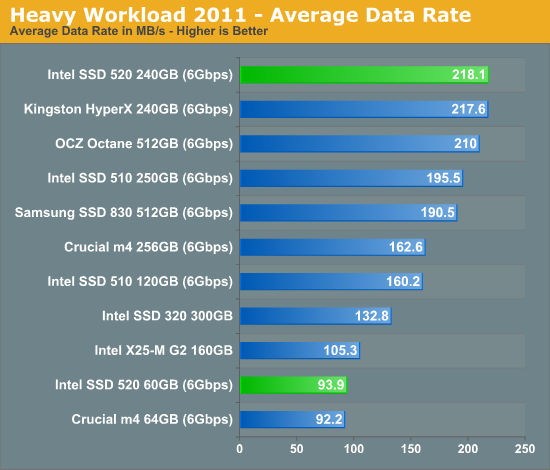
SandForce has always done well in our Heavy Workload test, and the 520 is no different. For heavy multitasking workloads, the 520 is the fastest SSD money can buy. Note that its only hindrance is incompressible write speed, which we do get a hint of in our breakdown of read/write performance below.

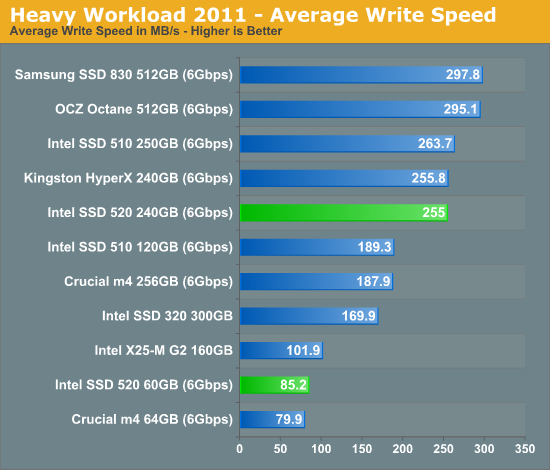
The next three charts just represent the same data, but in a different manner. Instead of looking at average data rate, we're looking at how long the disk was busy for during this entire test. Note that disk busy time excludes any and all idles, this is just how long the SSD was busy doing something:
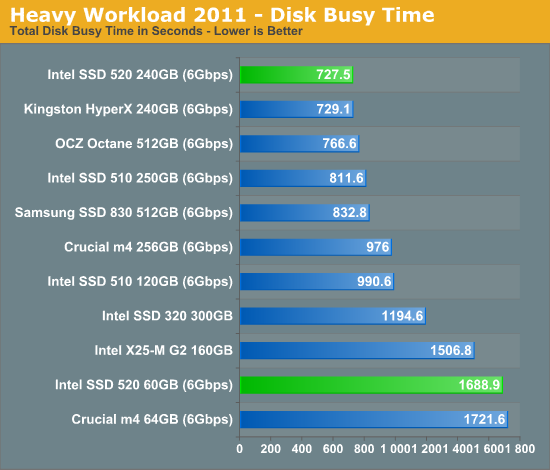
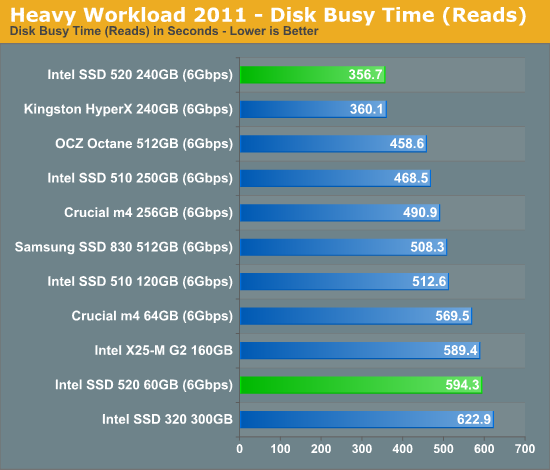
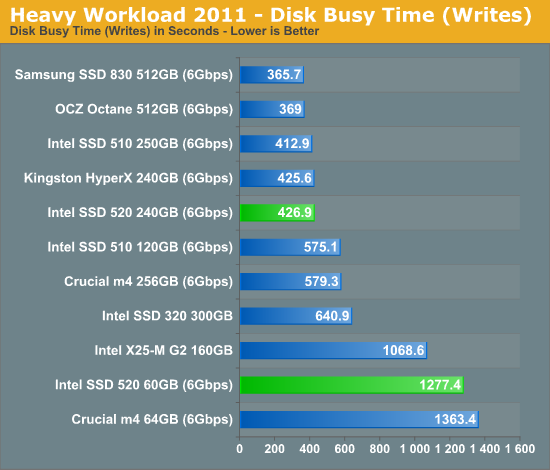










138 Comments
View All Comments
Sunburn74 - Monday, February 6, 2012 - link
A short, but more indepth article on your findings concerning the BSOD bugs afflicting the Sandforce ssds would be well appreciated by many. The findings of a tech supergenius like yourself would help dispel all the quackery that is floating about concerning what causes it and what doesn't and ultimately will help us all.Shadowmaster625 - Monday, February 6, 2012 - link
"The first possibility is that SandForce has been made aware of flaws in its current firmware and chooses against (or is legally prevented from) disclosing it to its partners"In other words, Intel is possibly forcing a company to sell knowingly defective product to its competitors. That is exactly the type of criminality that I would expect from intel. If this is true then it should be another billion dollars at some point, probably 8 years from now.
Rick83 - Tuesday, February 7, 2012 - link
I don't see any "forcing to sell" happening.I do see in-house development not being given away for free, which is normal business behavior. I'm pretty sure, for the right price, Intel would be willing to share the information.
In fact, the problem lies entirely with SandForce and the people blindly using their firmware, without doing the testing. Yes it's cheaper in the short run, but if you have to deal with a bunch of returns and your name being sullied, it may not pay off.
Also, I remember OCZ having an excllusive deal with SandForce at the start, where they were getting preferential treatment with regards to patches - that's criminal too?
DanSmith - Monday, February 6, 2012 - link
Great article thanks. The documentation on the 520 states it supports AES FDE but judging from my experience with other SF based drives it can be extremely hit and miss, with OCZ for example telling customers on their forum not to use it as it can permanently damage drives!!I hope to read more about AES on the 520 in the real world when you cover SSD's and enterprise soon.
Cheers, Dan
Beenthere - Monday, February 6, 2012 - link
Even after "extensive validation" of their own SSD controller Intel had Bugs and had to issue a firmware update to fix it. I'm not going to be so sure that the SF controller validation is any better than Intel's controller until the 520 series drives have been out in the field for 18-24 months.FunBunny2 - Monday, February 6, 2012 - link
-- until the 520 series drives have been out in the field for 18-24 months.Given the rate of change in SSDland, there'll likely not be any 520s for sale in that time frame.
Beenthere - Tuesday, February 7, 2012 - link
Then it's probably smart to let the guinea pigs suffer thru yet another half-baked SSD instead of wasting our time and money to be unpaid Beta testers for negligent SSD makers. Anand was correct: WAIT 6-12 months to see if they sort out most of the Bugs... He may need to extend that time frame to 36-48 months?As you can see from the numerous comments here, the 520 already has one or more BSOD reports at Intel's support site and people with OCZ and other drives still have issues even after the SandFarce firmware updates. On-The-Job-Training seems to be the current SSD strategy for most if not all SSD companies... which IMO is a disgrace.
FunBunny2 - Wednesday, February 8, 2012 - link
I'm no fan of SF. It's only that SSD land is vastly different from HDD land.FelixO - Monday, February 6, 2012 - link
Hi,I am very tempted to get one of these because I want to shove it in a machine and forget about it for 5 years (rather than upgrade regularly).
However the performance after being filled up is pretty worrying since that it something I do all the time!
Anand, in your SSD reviews you used to talk about what % of the disk was reserved space to help with avoidance of write amplification, or to assist with wear-levelling (or something like that!). You also used to say whether formatting the disk or doing a secure-erase would get you back to peak performance.
You seem to have omitted these discussions from recent reviews.
Any comments on those issues for this drive (Or the Samsung 830)?
Is it possible to adjust the reserved area on these drives? Will that mitigate the problems associated with completely filling the drives? Any comments on running these drives under Linux?
Thanks
4G92 - Monday, February 6, 2012 - link
Can anyone (Anand?) confirm if the Vertex 2 drives have this same Sandforce bug? I know the controllers are different, but my symptoms are EXACTLY the same.I just replaced my Vertex 2 with a Crucial M4 and the problems have now stopped, so I suspect the OCZ drive is the cause of the lockups...